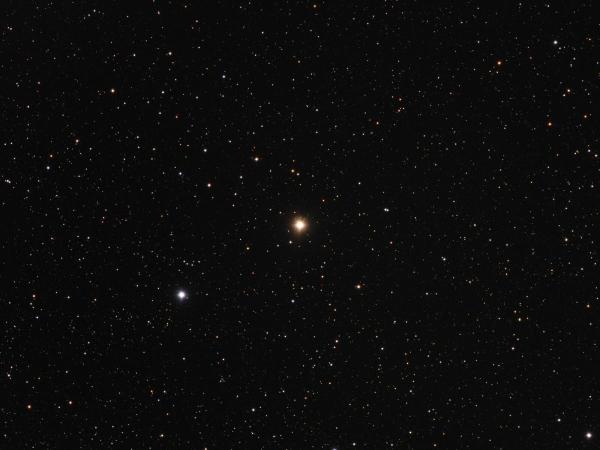
AAVSO data has helped unveil the mysteries of Rho Cas and stars like it. | By Tim Lyster
Among the multitude of stars in the universe—some estimates put the number at 1 septillion, or 1 followed by 24 zeros—there are certain examples that challenge our understanding of stellar properties due to their unusual characteristics. One such object is the yellow hypergiant.
These unusual stars—stellar behemoths nearing the end of their lives—are among the most enigmatic objects in the universe. Their massive size, extreme luminosity, and dramatic outbursts make them both fascinating and challenging to investigate. A recent study published in Astronomy & Astrophysics is shedding new light on the pulsations, outbursts, and evolutionary paths of these stars, focusing on Rho Cassiopeiae (ρ Cas), HR 8752, HR 5171A, and HD 179821.
ρ Cas lies in the southwestern part of the constellation, southwest of Caph, the rightmost point of the W. It is one of the best-studied stars of its kind. Its absolute magnitude is -9.5—compared to our own Sun’s 4.83—making it one of the most luminous stars known, but a combination of intervening dust and great distance means it looks to the unaided eye like an unremarkable 4.5-magnitude star.
In this case, looks can be deceiving!
The “Yellow Evolutionary Void:” A Stellar Transition
The research, conducted by an international team from Leiden University, the Royal Observatory of Belgium, and Durham University, provides significant insights into our understanding of yellow hypergiants. Notably, the authors incorporated valuable data from the AAVSO, once again highlighting the crucial role amateur astronomers can play in modern astrophysical research.
Yellow hypergiants occupy a unique position in the Hertzsprung-Russell diagram, sitting in what is called the yellow evolutionary void. This region represents a phase in stellar evolution where massive stars undergo rapid changes in temperature and luminosity. The paper details how ρ Cas exhibits cyclical outbursts approximately every 10 to 40 years, with significant fluctuations in surface temperature ranging from 4,500°C to 7,500°C. These outbursts are believed to be driven by vigorous pulsations within the star’s interior, leading to the ejection of material and dramatic changes in brightness.
AAVSO’s Crucial Contribution
For the investigation of yellow hypergiants, AAVSO observers contributed critical visual and photometric observations that filled gaps in the light curves of ρ Cas, particularly during its 2013 outburst. These contributions were essential for constructing a continuous and accurate dataset spanning over a century, allowing researchers to analyze the star’s behavior across a large time domain.
The study deployed a new photometric parameter and four temperature calibration relations to analyze the long-term variations in the median (B−V) color index of ρ Cas. By combining these methods with AAVSO’s extensive observational data, the team was able to trace the star’s pulsation cycles and outbursts with remarkable precision. This collaboration underscores the invaluable role of amateur astronomers in advancing our understanding of complex astrophysical phenomena.
Insights into Stellar Evolution
The team’s findings have profound implications for our understanding of stellar evolution. The cyclical outbursts observed in ρ Cas suggest that yellow hypergiants undergo rapid and significant changes in their outer layers, potentially leading to the formation of luminous blue variables or even core-collapse supernovae. The detailed analysis of temperature variations and light curves provides new insights into the mechanisms driving these outbursts and the evolutionary paths of massive stars.
Furthermore, the study’s methodology, combining long-term photometric observations with advanced calibration techniques, sets a new standard for analyzing variable stars. The incorporation of AAVSO data exemplifies the power of citizen science in contributing to high-impact astronomical research.

